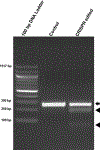Use of AAV Vectors for CRISPR-Mediated In Vivo Genome Editing in the Retina
- PMID: 30783971
- PMCID: PMC6730636
- DOI: 10.1007/978-1-4939-9139-6_7
Use of AAV Vectors for CRISPR-Mediated In Vivo Genome Editing in the Retina
Abstract
Degenerative retinal diseases such as retinitis pigmentosa (RP) and Leber's congenital amaurosis (LCA) may lead to blindness without effective treatment. With the rapid advancement of the CRISPR/Cas9 genome editing technology, in vivo application of CRISPR/Cas9 holds immense potential for treatment of these diseases. Adeno-associated virus (AAV) vectors are an ideal gene transfer tool for delivery of CRISPR components to the retina. Here, we describe a protocol for utilizing an AAV-based CRISPR/Cas9 system for in vivo genome editing in the retina.
Keywords: AAV vector; CRISPR/Cas9; Gene therapy; Genome editing; Retina; Retinal degeneration.
Figures

Similar articles
-
Methods for In Vivo CRISPR/Cas Editing of the Adult Murine Retina.Methods Mol Biol. 2018;1715:113-133. doi: 10.1007/978-1-4939-7522-8_9. Methods Mol Biol. 2018. PMID: 29188510
-
AAV-CRISPR Gene Editing Is Negated by Pre-existing Immunity to Cas9.Mol Ther. 2020 Jun 3;28(6):1432-1441. doi: 10.1016/j.ymthe.2020.04.017. Epub 2020 Apr 19. Mol Ther. 2020. PMID: 32348718 Free PMC article.
-
Somatic Gene Editing of GUCY2D by AAV-CRISPR/Cas9 Alters Retinal Structure and Function in Mouse and Macaque.Hum Gene Ther. 2019 May;30(5):571-589. doi: 10.1089/hum.2018.193. Epub 2018 Dec 20. Hum Gene Ther. 2019. PMID: 30358434 Free PMC article.
-
CRISPR Systems Suitable for Single AAV Vector Delivery.Curr Gene Ther. 2022;22(1):1-14. doi: 10.2174/1566523221666211006120355. Curr Gene Ther. 2022. PMID: 34620062 Review.
-
CRISPR-Based Genome Editing as a New Therapeutic Tool in Retinal Diseases.Mol Biotechnol. 2021 Sep;63(9):768-779. doi: 10.1007/s12033-021-00345-4. Epub 2021 May 31. Mol Biotechnol. 2021. PMID: 34057656 Review.
Cited by
-
Antiproliferative effects of AAV-delivered CRISPR/Cas9-based degradation of the HPV18-E6 gene in HeLa cells.Sci Rep. 2022 Feb 9;12(1):2224. doi: 10.1038/s41598-022-06025-w. Sci Rep. 2022. PMID: 35140292 Free PMC article.
-
Efficient CRISPR editing with a hypercompact Cas12f1 and engineered guide RNAs delivered by adeno-associated virus.Nat Biotechnol. 2022 Jan;40(1):94-102. doi: 10.1038/s41587-021-01009-z. Epub 2021 Sep 2. Nat Biotechnol. 2022. PMID: 34475560 Free PMC article.
-
CRISPR/Cas9-Mediated Gene Therapy for Glioblastoma: A Scoping Review.Biomedicines. 2024 Jan 21;12(1):238. doi: 10.3390/biomedicines12010238. Biomedicines. 2024. PMID: 38275409 Free PMC article.
-
Restoration of RPGR expression in vivo using CRISPR/Cas9 gene editing.Gene Ther. 2022 Feb;29(1-2):81-93. doi: 10.1038/s41434-021-00258-6. Epub 2021 Jul 14. Gene Ther. 2022. PMID: 34257417 Free PMC article.
-
Inhibition of Hepatitis B Virus by AAV8-Derived CRISPR/SaCas9 Expressed From Liver-Specific Promoters.Front Microbiol. 2021 Jun 26;12:665184. doi: 10.3389/fmicb.2021.665184. eCollection 2021. Front Microbiol. 2021. PMID: 34254007 Free PMC article.
References
-
- Bakondi B, Lv W, Lu B, Jones MK, Tsai Y, Kim KJ, Levy R, Akhtar AA, Breunig JJ, Svendsen CN, Wang S (2016) In vivo CRISPR/Cas9 gene editing corrects retinal dystrophy in the S334ter-3 rat model of autosomal dominant retinitis pigmentosa. Mol Ther 24 (3):556–563. 10.1038/mt.2015.220 - DOI - PMC - PubMed
MeSH terms
Substances
Grants and funding
LinkOut - more resources
Full Text Sources
Other Literature Sources
Research Materials

